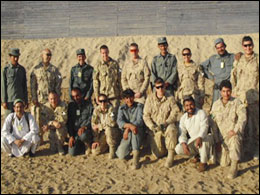Archived Document
Priority 1. Enable the Afghan National Security Forces in Kandahar to sustain a more secure environment and promote law and order.
The Afghan National Security Forces include the Afghan National Army and the Afghan National Police. In this quarter, both the ANA and ANP demonstrated tangible progress when measured against Canada’s objectives.
Canada’s 2011 objective for the Afghan National Army is that the ANA in Kandahar will demonstrate an increased capacity to conduct operations and sustain a more secure environment in key districts of Kandahar, with support from ISAF allies.
In this quarter, Canada’s Task Force Kandahar continued to work with the ANSF to increase security in Kandahar City and the surrounding populated areas, and build on our permanent security presence in Panjwayi and Zhari, despite the difficulties that come with gaining trust within the local communities of these districts.
During this quarter, the ANA’s capacity to conduct operations increased: a third ANA kandak (or battalion) achieved the ability to conduct near-autonomous operations, and is now shouldering more of the security burden in and around Kandahar City. In addition, one ANA kandak—with Canadian Forces mentors—participated in Operation Moshtarak in Helmand province, and performed at a high level.
Retention and recruitment challenges noted in the previous quarter were reduced in this quarter, as a result of new pay incentives and a redoubled recruiting effort. Based on this progress, ANA growth appears to be on target to meet ISAF objectives by 2011.

After a successful day of training, members of a
Canadian Police Operational Mentor and Liaison
Team line up for a photo with their Afghan
National Police (ANP) crew. Canadian police and
Canadian Forces are working together to train and
mentor the ANP to increase their ability to promote
law and order.
While the Afghan National Police continued to deal with serious challenges, including corruption and high attrition rates, its performance in handling security issues improved. Nowhere was this more evident than in the ANP response to the coordinated suicide attacks in Kandahar City on March 13, when the ANP demonstrated a higher level of professionalism and more advanced capabilities than in the past.
Training and mentoring of the ANP continued to advance through several initiatives. First, the ANP continued to benefit from an enhanced 24/7 training and mentoring regime in Kandahar City, largely through the Kandahar Model Police Plan. Second, advancements in Canadian civilian police mentoring in this quarter were further enabled by the increase in U.S. resources, allowing a greater mentoring focus by Canada on ANP provincial headquarters. Finally, mentoring by Canadian civilian police and U.S. Military Police was extended to senior ANP officers for planning and executing joint ANSF operations in both the city and the province.
In this quarter, the expansion of the Canadian-led Kandahar Provincial Reconstruction Team (KPRT) Training Centre—the training site for ANP and corrections officers—was completed, as was the inaugural Leadership and Management training course for police officers. A new basic training course also began in February, to provide eight weeks of training for new ANP recruits.
Canada also continued to build capacity within the Afghan corrections system. Four Sarpoza Prison correctional officers graduated in February from the Train-the-Trainer program implemented and administered by Correctional Service Canada, whose officials also mentored Sarpoza staff on crisis management procedures during a series of prison incidents in January.
Canada’s role in building this type of capacity and expertise was especially evident when Sarpoza prison staff and other security personnel successfully withstood the major brunt of the March 13 suicide attacks, in stark contrast to the 2008 attack on Sarpoza that freed hundreds of prisoners into the streets of Kandahar.
With respect to justice reform, we have exceeded our target of equipping a minimum of three justice facilities in Kandahar province. Canada continues to deliver basic and advanced training for Kandahar province justice officials, including delivery this quarter of training in managing medical forensic evidence. Canada also funded 20 workshops in Kandahar City to promote awareness of legal rights to primarily female audiences, and co-funded a March corrections conference in Kabul that focused on strengthening Afghan ownership of corrections reform.